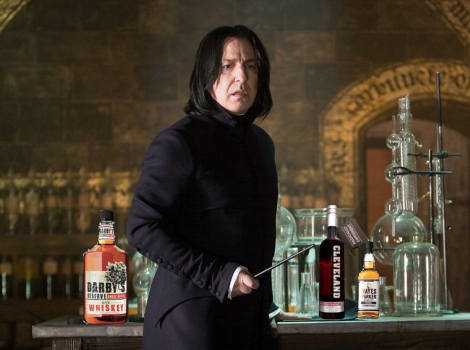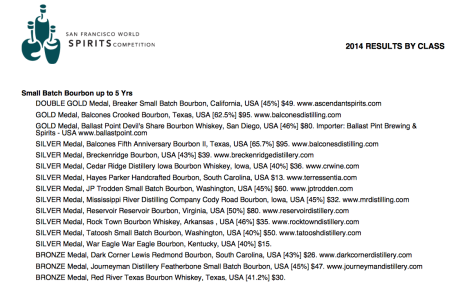Member Sign In Create Account
Login with email and password
No account yet? Register Now

There is something uncomfortably arrogant in the way “quick-aging” whiskey producers respond to skepticism and negative reviews. If you don’t buy that Terressentia’s TerrePURE process can take a 6 month old sourced bourbon and mature it to equal, or even best, a traditionally aged 4 to 6 year bourbon, you are closed minded and stuck in the mud. If you struggle to believe that Cleveland Whiskey can replicate 24 hours in a full size barrel in just one “cycle” of their proprietary machine, you are a “traditionalist” and “afraid” of what Cleveland Whiskey is doing. They patronize the “old way” as a practice in tradition rather than necessity, while passively hinting that time, or even barrels, are wholly unnecessary to mature whiskey. I think they are full of crap.
To be specific, Cleveland Whiskey’s Tom Lix has claimed his 6 month old whiskey is equivalent to a 6 year whiskey, and Terressentia joins that claim, saying their whiskey replicates 6 years of maturation, but also hedges down to 4 years in different interviews. And while it would be one thing to say your lab born bourbon “tasted” equal to much older products, which no one could objectively refute, both Cleveland and Terressentia continually use terms that go beyond subjective aspects of whiskey production.
Lix went as far as to say his technology “actually accelerates the aging process” which is a pretty liberal usage of the word “actually,” and Earl Hewlett, the CEO of Terressentia, says they use “chemistry instead of the oak barrel” which “replicated more than four years of barrel aging“. Again, probably stretching the definition of “replicating” a bit. Both company heads make statements that move beyond the subjective, saying they are recreating and enhancing everything that is taking place inside the traditional barrel, and there should be definitive science to reflect those claims.
I mean, when Jefferson’s says their 4 year Ocean Aged is competitive with a 19 year old bourbon, it is easy to chalk it up to Jefferson’s being Jefferson’s, like the drunk uncle that blames his appendicitis on Obama (Obama!). Making claims that your lab is revolutionizing barrel maturation, “accelerating” and “replicating” things like Louis Pasteur on a good day, needs more proof than say, a Silver from the San Francisco World Spirits Competition or a taste test so “blind” that no one actually remembers it taking place.

Both producers continually point to science, or even independent lab research, to support their claims, but neither provides the research in whole, just snippets that only offer a keyhole to peek through. If you want verification of whether or not their whiskey is any good, Cleveland Whiskey points to a secret, closed door, underground (possibly imagined in a fugue state) blind taste test where Lix swears up to 70% of the participants chose Cleveland over 9 year Knob – F’ing – Creek. Terressentia’s Hewlette simply asks you to kiss the ring, and points to sales figures of their treated products, as well as a pair of silver medals and a handful of bronze medals from the 2014 SFWSC (including some for flavored whiskies).
No one that has ever drank Cleveland believes this taste test actually took place, but it ran in Forbes, so there is no stopping that wave of PR. As for Terressentia pointing to isolated sales figures, the rising tide raises all ships, and in this bull market, sales figures are simply proof you exist, not that your product is good. Unless those sales figures are stacked up against true 4 year products like Beam, the new IW Harper or Rittenhouse, they really mean nothing.
As for the medals Terressentia wears so proudly, know that SFWSC has two different golds, a “Gold” gold, and then a “Double Gold” gold, so silver is practically bronze, and a bronze is basically a participation ribbon. No one brags about a silver from the SFWSC, and definitely not about bronze. Not even Caskers. Plus, the SFWSC breaks their categories up by ages, so all of the Terressentia treated products competed in the “under 5 year” category, so it’s not as if they tied Blanton’s, which also got Silver. No. They tied brands like War Eagle and Tatoosh, and only beat three even more obscure brands like Dark Corner Lewis Redmond Bourbon, Journeyman’s Featherbone Bourbon and Red River Texas Bourbon, so context is brutal to that particular claim, and that is if you put any credence in these competitions to begin with.

Sadly, the real validation that gave them those sales to begin with took place before anyone really tried their products. The mainstream media, always willing to publish something about whiskey, eagerly ran with one-liners from these guys like, “We can put it through our process. It takes about eight hours, and we have replicated more than four years of barrel aging.” and “Essentially, we’re applying science and technology to what was going on in those barrels“. These quotes aren’t running on BourbonBlog or Drink Hacker, they are running on NPR, Forbes, Wired, Inc., local affiliates of national news organizations, and The Huffington Post. When you see claims like these in publications like those, it is a lot easier to believe the claims at face value because you assume some fact-checking took place.
Most don’t even attempt to define barrel maturation and maturation reactions for the readers, and when they do try and get some balance from the other side, they settle for superficial responses that sound petty or even a little intimidated (check what Julian says). By the time these stories hit the internet, they are so stacked in favor of these new-fangled producers that any counter argument gets dismissed as unenlightened or closed minded, and it is working.
But what about the science? Shouldn’t somewhere, someone be asking these guys about oxygenation and filtration when you don’t have the barrel as a barrier (Cleveland), or filtration, extraction or over-oxygenation when you don’t have a barrel at all (TerrePURE)? What about evaporation, which neither allow for, or the importance of oak decomposition, which takes years to develop? These guys are definitely accomplishing some maturation reactions, and TerrePURE probably works great on clear spirits, but there are numerous reactions taking place inside a barrel that result in mature whiskey, and they are mutually exclusive. Without each reaction working parallel with the others, you basically have a cogged wheel with only one cog, or a ladder with no rungs.
For Part II of this little series which I hope to post next week, with the help of my old organic chem professor and a gentleman at the Scotch Whiskey Research Institute in Edinburgh, I will attempt to explain what is happening with these “quick aging” whiskies, and more importantly, what is not. These guys have great intent, I really do believe that, but they are years, maybe decades away from being able to say they are “replicating” or “accelerating” traditional barrel maturation, and I think they know that.
I’ll post the science as I understand it and see what shakes out. I know there are a lot of really smart science folks in this community, so hopefully we also get a good open source conversation.
Login with a social network